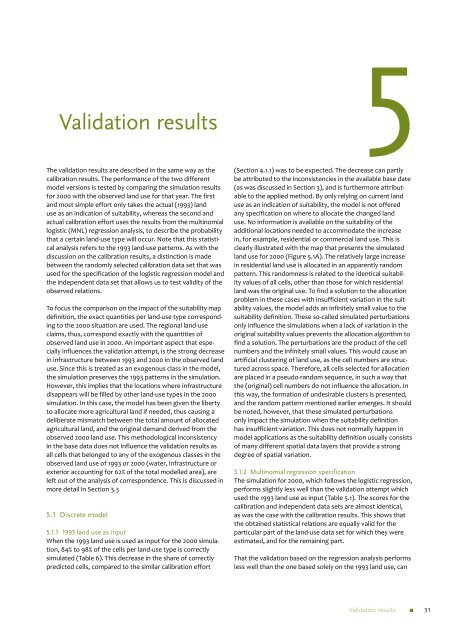PBL rapport 550026002 Calibration and validation of the land use ...
PBL rapport 550026002 Calibration and validation of the land use ...
PBL rapport 550026002 Calibration and validation of the land use ...
You also want an ePaper? Increase the reach of your titles
YUMPU automatically turns print PDFs into web optimized ePapers that Google loves.
Validation results 5<br />
The <strong>validation</strong> results are described in <strong>the</strong> same way as <strong>the</strong><br />
calibration results. The performance <strong>of</strong> <strong>the</strong> two different<br />
model versions is tested by comparing <strong>the</strong> simulation results<br />
for 2000 with <strong>the</strong> observed l<strong>and</strong> <strong>use</strong> for that year. The first<br />
<strong>and</strong> most simple effort only takes <strong>the</strong> actual (1993) l<strong>and</strong><br />
<strong>use</strong> as an indication <strong>of</strong> suitability, whereas <strong>the</strong> second <strong>and</strong><br />
actual calibration effort <strong>use</strong>s <strong>the</strong> results from <strong>the</strong> multinomial<br />
logistic (MNL) regression analysis, to describe <strong>the</strong> probability<br />
that a certain l<strong>and</strong>-<strong>use</strong> type will occur. Note that this statistical<br />
analysis refers to <strong>the</strong> 1993 l<strong>and</strong>-<strong>use</strong> patterns. As with <strong>the</strong><br />
discussion on <strong>the</strong> calibration results, a distinction is made<br />
between <strong>the</strong> r<strong>and</strong>omly selected calibration data set that was<br />
<strong>use</strong>d for <strong>the</strong> specification <strong>of</strong> <strong>the</strong> logistic regression model <strong>and</strong><br />
<strong>the</strong> independent data set that allows us to test validity <strong>of</strong> <strong>the</strong><br />
observed relations.<br />
To focus <strong>the</strong> comparison on <strong>the</strong> impact <strong>of</strong> <strong>the</strong> suitability map<br />
definition, <strong>the</strong> exact quantities per l<strong>and</strong>-<strong>use</strong> type corresponding<br />
to <strong>the</strong> 2000 situation are <strong>use</strong>d. The regional l<strong>and</strong>-<strong>use</strong><br />
claims, thus, correspond exactly with <strong>the</strong> quantities <strong>of</strong><br />
observed l<strong>and</strong> <strong>use</strong> in 2000. An important aspect that especially<br />
influences <strong>the</strong> <strong>validation</strong> attempt, is <strong>the</strong> strong decrease<br />
in infrastructure between 1993 <strong>and</strong> 2000 in <strong>the</strong> observed l<strong>and</strong><br />
<strong>use</strong>. Since this is treated as an exogenous class in <strong>the</strong> model,<br />
<strong>the</strong> simulation preserves <strong>the</strong> 1993 patterns in <strong>the</strong> simulation.<br />
However, this implies that <strong>the</strong> locations where infrastructure<br />
disappears will be filled by o<strong>the</strong>r l<strong>and</strong>-<strong>use</strong> types in <strong>the</strong> 2000<br />
simulation. In this case, <strong>the</strong> model has been given <strong>the</strong> liberty<br />
to allocate more agricultural l<strong>and</strong> if needed, thus causing a<br />
deliberate mismatch between <strong>the</strong> total amount <strong>of</strong> allocated<br />
agricultural l<strong>and</strong>, <strong>and</strong> <strong>the</strong> original dem<strong>and</strong> derived from <strong>the</strong><br />
observed 2000 l<strong>and</strong> <strong>use</strong>. This methodological inconsistency<br />
in <strong>the</strong> base data does not influence <strong>the</strong> <strong>validation</strong> results as<br />
all cells that belonged to any <strong>of</strong> <strong>the</strong> exogenous classes in <strong>the</strong><br />
observed l<strong>and</strong> <strong>use</strong> <strong>of</strong> 1993 or 2000 (water, infrastructure or<br />
exterior accounting for 62% <strong>of</strong> <strong>the</strong> total modelled area), are<br />
left out <strong>of</strong> <strong>the</strong> analysis <strong>of</strong> correspondence. This is discussed in<br />
more detail in Section 3.3<br />
5.1<br />
Discrete model<br />
5.1.1 1993 l<strong>and</strong> <strong>use</strong> as input<br />
When <strong>the</strong> 1993 l<strong>and</strong> <strong>use</strong> is <strong>use</strong>d as input for <strong>the</strong> 2000 simulation,<br />
84% to 98% <strong>of</strong> <strong>the</strong> cells per l<strong>and</strong>-<strong>use</strong> type is correctly<br />
simulated (Table 6). This decrease in <strong>the</strong> share <strong>of</strong> correctly<br />
predicted cells, compared to <strong>the</strong> similar calibration effort<br />
(Section 4.1.1) was to be expected. The decrease can partly<br />
be attributed to <strong>the</strong> inconsistencies in <strong>the</strong> available base date<br />
(as was discussed in Section 3), <strong>and</strong> is fur<strong>the</strong>rmore attributable<br />
to <strong>the</strong> applied method. By only relying on current l<strong>and</strong><br />
<strong>use</strong> as an indication <strong>of</strong> suitability, <strong>the</strong> model is not <strong>of</strong>fered<br />
any specification on where to allocate <strong>the</strong> changed l<strong>and</strong><br />
<strong>use</strong>. No information is available on <strong>the</strong> suitability <strong>of</strong> <strong>the</strong><br />
additional locations needed to accommodate <strong>the</strong> increase<br />
in, for example, residential or commercial l<strong>and</strong> <strong>use</strong>. This is<br />
clearly illustrated with <strong>the</strong> map that presents <strong>the</strong> simulated<br />
l<strong>and</strong> <strong>use</strong> for 2000 (Figure 5.1A). The relatively large increase<br />
in residential l<strong>and</strong> <strong>use</strong> is allocated in an apparently r<strong>and</strong>om<br />
pattern. This r<strong>and</strong>omness is related to <strong>the</strong> identical suitability<br />
values <strong>of</strong> all cells, o<strong>the</strong>r than those for which residential<br />
l<strong>and</strong> was <strong>the</strong> original <strong>use</strong>. To find a solution to <strong>the</strong> allocation<br />
problem in <strong>the</strong>se cases with insufficient variation in <strong>the</strong> suitability<br />
values, <strong>the</strong> model adds an infinitely small value to <strong>the</strong><br />
suitability definition. These so-called simulated perturbations<br />
only influence <strong>the</strong> simulations when a lack <strong>of</strong> variation in <strong>the</strong><br />
original suitability values prevents <strong>the</strong> allocation algorithm to<br />
find a solution. The perturbations are <strong>the</strong> product <strong>of</strong> <strong>the</strong> cell<br />
numbers <strong>and</strong> <strong>the</strong> infinitely small values. This would ca<strong>use</strong> an<br />
artificial clustering <strong>of</strong> l<strong>and</strong> <strong>use</strong>, as <strong>the</strong> cell numbers are structured<br />
across space. Therefore, all cells selected for allocation<br />
are placed in a pseudo-r<strong>and</strong>om sequence, in such a way that<br />
<strong>the</strong> (original) cell numbers do not influence <strong>the</strong> allocation. In<br />
this way, <strong>the</strong> formation <strong>of</strong> undesirable clusters is presented,<br />
<strong>and</strong> <strong>the</strong> r<strong>and</strong>om pattern mentioned earlier emerges. It should<br />
be noted, however, that <strong>the</strong>se simulated perturbations<br />
only impact <strong>the</strong> simulation when <strong>the</strong> suitability definition<br />
has insufficient variation. This does not normally happen in<br />
model applications as <strong>the</strong> suitability definition usually consists<br />
<strong>of</strong> many different spatial data layers that provide a strong<br />
degree <strong>of</strong> spatial variation.<br />
5.1.2 Multinomial regression specification<br />
The simulation for 2000, which follows <strong>the</strong> logistic regression,<br />
performs slightly less well than <strong>the</strong> <strong>validation</strong> attempt which<br />
<strong>use</strong>d <strong>the</strong> 1993 l<strong>and</strong> <strong>use</strong> as input (Table 5.1). The scores for <strong>the</strong><br />
calibration <strong>and</strong> independent data sets are almost identical,<br />
as was <strong>the</strong> case with <strong>the</strong> calibration results. This shows that<br />
<strong>the</strong> obtained statistical relations are equally valid for <strong>the</strong><br />
particular part <strong>of</strong> <strong>the</strong> l<strong>and</strong>-<strong>use</strong> data set for which <strong>the</strong>y were<br />
estimated, <strong>and</strong> for <strong>the</strong> remaining part.<br />
That <strong>the</strong> <strong>validation</strong> based on <strong>the</strong> regression analysis performs<br />
less well than <strong>the</strong> one based solely on <strong>the</strong> 1993 l<strong>and</strong> <strong>use</strong>, can<br />
Validation results 31
















